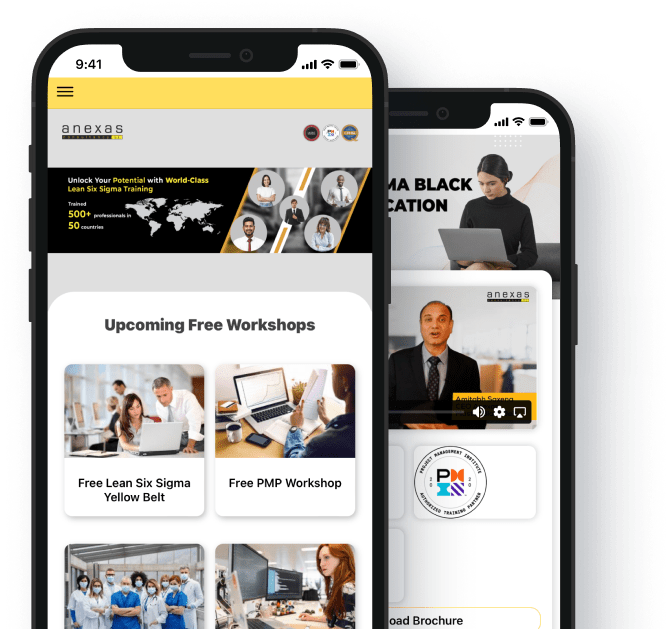Table of Contents
Share This Article
Top 15 Lean Six Sigma Tools Everyone Should Know
- 27916 views
Introduction to Lean Six Sigma tools
Significance of Lean Six Sigma tools in process improvement
The significance of Lean Six Sigma tools in process improvement cannot be overstated, as they form the backbone of a systematic and data-driven approach to enhancing operational efficiency and minimizing defects. Lean Six Sigma, a hybrid methodology combining Lean principles and Six Sigma techniques, focuses on identifying and eliminating waste, reducing variation, and optimizing processes to deliver high-quality products or services. The tools associated with Lean Six Sigma play a pivotal role in achieving these objectives by providing practitioners with structured methods for problem-solving, data analysis, and continuous improvement. By embracing Lean Six Sigma tools, organizations can streamline their operations, enhance customer satisfaction, and achieve substantial cost savings. The methodology’s disciplined and results-oriented approach empowers practitioners to tackle complex challenges, leading to a culture of continuous improvement within an organization.
Overview of the top 15 Lean Six Sigma tools
- SIPOC (Supplier, Input, Process, Output, Customer): A foundational tool for mapping the high-level process flow, identifying key stakeholders, and understanding the overall context.
- Project Charter: Defines the project’s scope, objectives, and team roles, providing a roadmap for successful project execution.
- Voice of the Customer (VOC) Analysis: Gathers and analyzes customer feedback to ensure that projects align with customer expectations and needs.
- Process Mapping: Illustrates the sequence of steps in a process, aiding in the identification of inefficiencies and improvement opportunities.
- Data Collection Plan: Establishes a systematic approach for collecting relevant data to support informed decision-making.
- Measurement Systems Analysis (MSA): Evaluates the reliability and accuracy of measurement systems to ensure confidence in collected data.
- Capability Analysis: Assesses the capability of a process to meet customer specifications and identifies areas for improvement.
- Gage R&R (Repeatability and Reproducibility): Measures the precision and accuracy of measurement systems, crucial for reliable data.
- Fishbone Diagram (Ishikawa): Systematically identifies and categorizes potential causes of a problem to facilitate root cause analysis.
- 5 Whys: A simple yet powerful technique for digging deeper into the root causes of a problem by asking “why” iteratively.
- Pareto Analysis: Prioritizes problems or causes based on their significance, enabling focused improvement efforts.
- Scatter Diagram: Visualizes the relationship between two variables, aiding in understanding and addressing potential correlations.
- Regression Analysis: Determines the strength and nature of the relationship between variables, supporting predictive modeling.
- Failure Mode and Effects Analysis (FMEA): Proactively identifies and prioritizes potential failures in a process, allowing for preventive measures.
- Control Plan: Documents the strategies for maintaining process improvements over time, ensuring sustained success.

Define the Problem
Importance of clearly defining the problem
At the heart of any successful Lean Six Sigma initiative lies the paramount importance of clearly defining the problem at hand. This initial step serves as the foundation for the entire improvement process, setting the direction for subsequent activities. A well-defined problem statement provides clarity and focus, guiding practitioners towards meaningful solutions and preventing unnecessary deviations. By understanding the problem thoroughly, organizations can ensure that their efforts are aligned with strategic goals and that resources are utilized efficiently. Moreover, a precise problem definition facilitates the selection of appropriate tools and methodologies for analysis and improvement, contributing to the overall effectiveness of the Lean Six Sigma project.
Tools Used:
- SIPOC (Supplier, Input, Process, Output, Customer): A powerful tool for mapping out the high-level process flow and identifying the critical components, including suppliers, inputs, processes, outputs, and customers. SIPOC provides a visual representation of the entire system, offering clarity on the scope and boundaries of the problem. This aids in preventing scope creep and ensures that improvement efforts are targeted where they will have the most significant impact.
- Project Charter: This tool formalizes the project’s purpose, scope, objectives, and team roles. It serves as a guiding document throughout the project lifecycle, outlining the project’s boundaries and aligning team members with a common vision. The Project Charter provides a structured approach to problem definition, helping teams to articulate the problem’s significance and establish clear objectives for improvement.
- Voice of the Customer (VOC) Analysis: Understanding and incorporating the customer’s perspective is crucial for successful problem definition. VOC Analysis involves systematically gathering and analyzing customer feedback to identify their needs, expectations, and pain points. This tool ensures that the problem definition is customer-centric, aligning improvement efforts with the organization’s commitment to delivering value to its customers.
Measure Phase
Emphasis on accurate data collection and measurement
In the Lean Six Sigma methodology, an unwavering emphasis on accurate data collection and measurement serves as the linchpin for informed decision-making and successful process improvement initiatives. This emphasis recognizes the crucial role that reliable data plays in identifying and understanding the nuances of process inefficiencies and variations. Accurate data collection ensures that improvement efforts are based on a solid foundation of information, enhancing the precision and effectiveness of subsequent analyses and solutions. By prioritizing the collection of high-quality data, organizations can confidently navigate the complexities of their processes, leading to more impactful and sustainable improvements.
Tools Used:
- Process Mapping: A fundamental tool that visually represents the sequence of steps in a process, offering a clear overview of the entire workflow. Process Mapping aids in identifying potential areas for improvement and helps teams understand the relationships between different process elements, laying the groundwork for systematic data collection.
- Data Collection Plan: This tool provides a structured approach to gathering relevant data, outlining the types of data to be collected, the methods of collection, and the frequency of measurements. A well-designed Data Collection Plan ensures consistency and repeatability in data gathering, contributing to the reliability of subsequent analyses.
- Measurement Systems Analysis (MSA): MSA evaluates the reliability and accuracy of measurement systems, such as tools and instruments used in data collection. This tool ensures that the data collected is trustworthy, helping practitioners distinguish between variations originating from the measurement system and those inherent in the process itself.
- Capability Analysis: Once data is collected, Capability Analysis assesses the ability of a process to meet specified requirements. This tool provides insights into the process’s performance and identifies areas for improvement, guiding practitioners toward targeted interventions that address the root causes of variability.
- Gage R&R (Repeatability and Reproducibility): Gage R&R evaluates the precision and accuracy of measurement systems, particularly important when multiple operators are involved. By quantifying the variability introduced by different operators or measurement tools, Gage R&R helps ensure the consistency of data collection processes.
Analyze Phase
Root cause analysis for problem identification
Root cause analysis is a pivotal phase in the Lean Six Sigma methodology, as it focuses on understanding the underlying factors contributing to a problem, rather than merely addressing its symptoms. This approach is critical for sustainable process improvement, as it ensures that interventions target the root causes of issues, preventing recurrence and fostering long-term organizational resilience. The emphasis on root cause analysis aligns with the Lean Six Sigma philosophy of data-driven decision-making, enabling practitioners to make informed choices about where to direct improvement efforts for maximum impact. By systematically probing the factors influencing a problem, organizations can uncover hidden complexities, optimize processes, and implement strategic changes that lead to tangible and lasting improvements.
Tools Used:
- Fishbone Diagram (Ishikawa): Also known as a cause-and-effect or Ishikawa diagram, this tool is instrumental in visually representing the various potential causes contributing to a problem. It categorizes causes into key factors such as people, processes, equipment, and environment, facilitating a comprehensive exploration of all possible root causes.
- 5 Whys: A straightforward yet powerful questioning technique, the 5 Whys method involves iteratively asking “why” to dig deeper into the layers of causality behind a problem. This tool encourages a systematic exploration of cause-and-effect relationships, helping practitioners peel away surface-level issues to identify the true root causes.
- Pareto Analysis: Named after the Pareto Principle, which states that roughly 80% of effects come from 20% of causes, Pareto Analysis prioritizes and focuses on the most significant contributors to a problem. This tool aids in identifying the critical few factors that, when addressed, can have a substantial impact on overall improvement.
- Scatter Diagram: Visualizing the relationship between two variables, a Scatter Diagram helps identify potential correlations or patterns. This tool is particularly useful in root cause analysis when exploring how changes in one variable may influence another, providing valuable insights into cause-and-effect relationships.
- Regression Analysis: Employed to understand the strength and nature of relationships between variables, Regression Analysis goes beyond correlation by quantifying the impact of one variable on another. This statistical tool assists in identifying causal relationships and determining the extent to which changes in one factor contribute to changes in the outcome.

Improve Phase
Development and implementation of solutions
The phase of development and implementation of solutions in Lean Six Sigma is a pivotal stage where the insights gained from problem analysis are translated into concrete actions to drive process improvement. This stage emphasizes a proactive approach, focusing on designing and implementing effective solutions that address the identified root causes and mitigate potential risks. It is not merely about fixing the symptoms but about strategically engineering changes that enhance the overall efficiency and effectiveness of the process. This phase aligns with the overarching Lean Six Sigma goal of continuous improvement by fostering a culture of innovation, adaptability, and sustained excellence within an organization.
Tools Used:
- Failure Mode and Effects Analysis (FMEA): FMEA is a systematic tool that identifies potential failure modes in a process, assesses their impact, and prioritizes them based on severity, occurrence, and detectability. By quantifying risks and their potential consequences, organizations can proactively design solutions that address vulnerabilities, enhancing the robustness of their processes.
- Control Plan: A Control Plan is a comprehensive document that outlines the steps to maintain and control the improvements implemented during the Lean Six Sigma project. It serves as a roadmap for sustaining gains, ensuring that the organization maintains the newly optimized state and preventing a return to previous inefficiencies. A well-structured Control Plan is vital for the long-term success and sustainability of improvements.
- Design of Experiments (DOE): DOE is a statistical method that systematically varies input factors to observe their effect on output variables. This tool aids in optimizing processes by identifying the most influential factors and their optimal settings. By leveraging DOE, organizations can efficiently design and implement solutions that maximize the desired outcomes, leading to improved efficiency and effectiveness.
- Kaizen Events: Kaizen, meaning continuous improvement in Japanese, is embodied in Kaizen Events – focused, short-term initiatives that bring together cross-functional teams to implement rapid improvements. These events are a practical and efficient way to implement solutions quickly, fostering a culture of continuous improvement within the organization. Kaizen Events enable teams to collaborate, test solutions, and garner immediate feedback, accelerating the pace of improvement.
Control Phase
Ensuring sustained improvements
The Lean Six Sigma journey doesn’t conclude with the implementation of solutions; it extends to the critical phase of ensuring sustained improvements. This phase underscores the importance of establishing mechanisms to monitor and control processes over the long term, ensuring that the benefits of the improvements are not transient but become integral to the organizational fabric. The emphasis on sustained improvements aligns with the Lean Six Sigma philosophy of continuous enhancement, promoting a culture where gains are not only realized but also maintained, and organizations evolve into more efficient and resilient entities.
Tools Used:
- Statistical Process Control (SPC): SPC is a powerful tool that involves using statistical methods to monitor and control a process. By establishing control limits and employing statistical techniques, organizations can systematically evaluate process performance over time, detect deviations, and take corrective actions before issues escalate. SPC is fundamental to maintaining the stability and predictability of processes.
- Control Charts: Control Charts are a visual representation of process variation over time, displaying data points in relation to upper and lower control limits. These charts provide a dynamic view of process performance, allowing organizations to identify trends, shifts, or abnormal patterns that may require attention. Control Charts are essential for proactive monitoring and continuous improvement.
- Standard Work: Standard Work involves documenting and consistently following the best practices for a particular process. This tool establishes a baseline for operations, ensuring that everyone involved in the process follows standardized procedures. Standard Work contributes to process stability, facilitates training, and provides a basis for continuous improvement by identifying areas for optimization.
- Poka-Yoke (Mistake-Proofing): Poka-Yoke is a preventive approach to error-proofing processes, minimizing the likelihood of mistakes or defects. By incorporating fail-safes and mechanisms that prevent errors from occurring, organizations can enhance the reliability and consistency of their processes. Poka-Yoke aligns with the Lean Six Sigma goal of reducing variation and improving overall process performance.
Integration of Lean and Six Sigma
Synergy between Lean and Six Sigma methodologies
The synergy between Lean and Six Sigma methodologies represents a powerful approach to process improvement, combining the efficiency-focused principles of Lean with the data-driven and quality-centric techniques of Six Sigma. Lean methodologies prioritize the identification and elimination of waste, focusing on streamlining processes to enhance overall efficiency. On the other hand, Six Sigma emphasizes reducing variation and improving quality by applying statistical methods to data analysis. The collaboration of Lean and Six Sigma, often referred to as Lean Six Sigma, capitalizes on the strengths of both methodologies to create a comprehensive and holistic framework for continuous improvement. This synergy ensures that organizations not only optimize their processes for efficiency but also achieve a high level of quality, resulting in enhanced customer satisfaction, reduced costs, and increased competitiveness in the market.
Tools Used:
- Value Stream Mapping: Value Stream Mapping (VSM) is a foundational tool that plays a crucial role in identifying and eliminating waste in processes. It provides a visual representation of the entire process, highlighting areas of value-added and non-value-added activities. VSM enables organizations to streamline their processes by focusing on value-added steps and minimizing or eliminating activities that do not contribute to the overall value delivered to the customer.
- 5S (Sort, Set in Order, Shine, Standardize, Sustain): Originating from Lean principles, 5S is a systematic methodology for workplace organization and standardization. The five steps – Sort, Set in Order, Shine, Standardize, and Sustain – aim to create an organized, efficient, and visually controlled workplace. This tool not only contributes to waste reduction but also establishes a foundation for a disciplined and well-maintained work environment, aligning with the overall goals of both Lean and Six Sigma methodologies.
Case Studies
Real-world examples showcasing successful Lean Six Sigma implementations
Real-world examples stand as compelling evidence of the transformative impact that Lean Six Sigma methodologies can have on organizational processes across various industries. One notable instance is the success story of Motorola, which pioneered the application of Six Sigma principles in the 1980s, leading to significant quality improvements in their manufacturing processes. Another exemplary case is General Electric, under the leadership of Jack Welch, who embraced Six Sigma to drive operational excellence, resulting in substantial cost savings and improved customer satisfaction. Beyond manufacturing, Lean Six Sigma has demonstrated success in healthcare, exemplified by Virginia Mason Medical Center’s implementation of Lean principles to optimize patient flow, reduce waiting times, and enhance overall healthcare delivery. These examples underscore how Lean Six Sigma is not confined to a specific sector but rather presents a versatile and impactful methodology applicable across diverse industries.
Demonstrating the versatility of tools across industries
The versatility of Lean Six Sigma tools is evident in their application across a myriad of industries, showcasing their adaptability to unique organizational contexts. In the manufacturing sector, tools such as Process Mapping, Control Charts, and Design of Experiments have been instrumental in optimizing production processes, reducing defects, and improving overall quality. In the service industry, Lean Six Sigma tools like Value Stream Mapping, 5S, and Voice of the Customer (VOC) Analysis have proven effective in streamlining workflows, enhancing customer experiences, and minimizing service delivery errors. Healthcare organizations leverage tools such as Failure Mode and Effects Analysis (FMEA) and Statistical Process Control (SPC) to enhance patient safety, reduce medical errors, and improve healthcare outcomes. These examples highlight the flexibility and applicability of Lean Six Sigma tools, transcending industry boundaries and demonstrating their capacity to drive positive change in diverse organizational settings. The versatility of these tools is a testament to the adaptability of Lean Six Sigma methodologies, making them valuable assets for organizations seeking continuous improvement and operational excellence.
Conclusion
In conclusion, Lean Six Sigma stands as a dynamic and impactful methodology that has revolutionized the landscape of process improvement across industries. The fusion of Lean’s efficiency-driven principles with Six Sigma’s data-centric approach has created a holistic framework for organizations aiming to achieve operational excellence. The showcased success stories of companies like Motorola and General Electric, coupled with the versatile application of Lean Six Sigma tools across manufacturing, service, and healthcare sectors, underscore the enduring relevance and adaptability of this methodology. From problem definition through root cause analysis, solution development, and sustained improvement, Lean Six Sigma provides a structured and data-driven path to enhance efficiency, quality, and customer satisfaction. As organizations navigate the complexities of the modern business environment, the enduring principles of Lean Six Sigma continue to empower them in their pursuit of continuous improvement and excellence.

FAQs
What is Lean Six Sigma?
Lean Six Sigma is a methodology that combines Lean principles, focusing on waste reduction, with Six Sigma techniques, emphasizing data-driven decision-making and quality improvement. It aims to optimize processes and enhance overall organizational performance.
How does Lean Six Sigma differ from traditional Six Sigma?
While traditional Six Sigma primarily focuses on reducing defects and variation, Lean Six Sigma incorporates Lean principles to address waste, resulting in a more holistic approach to process improvement.
What are some common Lean Six Sigma tools used in process improvement?
Common tools include Value Stream Mapping, Process Mapping, Fishbone Diagram, Control Charts, 5 Whys, and Statistical Process Control. These tools help identify issues, analyze root causes, and implement effective solutions.
In which industries is Lean Six Sigma applicable?
Lean Six Sigma is versatile and applicable across various industries, including manufacturing, healthcare, finance, service, and technology. Its principles and tools can be adapted to different organizational contexts.
What is the DMAIC methodology in Lean Six Sigma?
DMAIC stands for Define, Measure, Analyze, Improve, and Control, representing the five phases of a Lean Six Sigma project. It provides a structured approach to problem-solving and continuous improvement.
How can organizations sustain improvements achieved through Lean Six Sigma?
Sustaining improvements involves implementing control mechanisms such as Standard Work, Statistical Process Control, and regular audits. It also requires fostering a culture of continuous improvement within the organization.
What role does leadership play in Lean Six Sigma implementation?
Leadership commitment is crucial for the success of Lean Six Sigma initiatives. Engaged leaders set the tone, allocate resources, and actively support the cultural shift towards continuous improvement.
Can small businesses benefit from Lean Six Sigma?
Yes, Lean Six Sigma principles can be scaled to fit the size and needs of small businesses. The methodology’s focus on efficiency, quality, and customer satisfaction is applicable to organizations of all sizes.
What is the importance of data in Lean Six Sigma projects?
Data plays a central role in Lean Six Sigma, guiding decision-making and providing a basis for process improvements. Accurate and relevant data is essential for measuring performance, identifying root causes, and evaluating the success of interventions.
How long does it take to see results from a Lean Six Sigma project?
The timeline for seeing results varies depending on the complexity of the project and the organization’s commitment. However, many organizations experience tangible improvements within a few months, with long-term benefits accruing over time.






